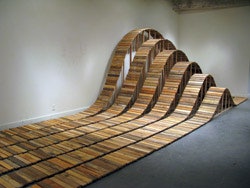Ebb & Flow
Artist explores uncharted waters with undulating art

"One thing that helps me decide what to make is what materials are available," says Trimble. "I was in Omaha at the time, and reclaimed pallet wood was easy to come by. I took a Skilsaw and cut those slats right off the pallets, then re-milled them a bit and put them through the table saw to make them all uniformly the same width and almost all the same thickness. The pallet pieces are kind of like Lego blocks, and I can put them together in any configuration and build in a way that dialogues with the architecture of the space each piece is in."
In creating this particular configuration, Trimble was inspired by the boardwalk near where he grew up on the Pacific Coast, and he also wanted to explore the metaphorical pathways one takes though life. "The path of being an artist is not exactly spelled out for you," says Trimble. "It's not a prescribed path where you follow a set of rules and a set of previous accomplishments that other people have already surpassed. You kind of make it up as you go. I think everybody is making their own pathway in life to some extent, so people can identify with that metaphor."
Sanctuary
Swimming helps young Iowan overcome major adversity

For Caleb Utesch, pools have provided a place to recover, on many levels. Caleb, 14, had his left leg amputated in the spring of 2005 after doctors discovered a malignant peripheral nerve sheath tumor above his knee.
The tumor was found in March, Caleb had his surgery in April, and he started chemotherapy in May. The then-nine-year-old boy, who had been a competitive swimmer before the cancer was detected, was back in the pool by June.
"I actually learned to swim again before I learned to walk again," Caleb told the Ames Tribune. "I remember really wanting to get back in the pool. It's meant a lot to my recovery."
A leader on his high school swim team, Caleb swims 10 times a week and has a big goal he's working toward: representing the United States in the Paralympics, which are held in conjunction with the Summer Olympics. Caleb is a Paralympics S-9 classification (one limb lost).
"He's one of the fastest S-9 swimmers in the nation already," Ames swim coach Dan Flannery told the Ames Tribune. "It's an honor he's earned. He's one of the hardest workers I've ever seen. And everybody on our team knows he's got some pretty superhuman powers once he's in the pool."
Slipping In
Rescuing animals, a car from backyard pools

Mikey's trouble began when he wandered away from his stable near Dix Hills, N.Y., got lost and became trapped up to his neck in a 7-foot-deep pool. It took 40 minutes, a firehose-turned-harness and dozens of rescuers to fish out the 16-year-old horse.
Mischief, a four-year-old horse in the U.K., fell into a neighbor's pool and had to be sedated before firefighters rescued the 14-hand animal. Fortunately, Mischief was used to water and walking over tarpaulins as part of his training. Once out of the pool, even though he was cold, the only injury was a small cut on his leg.
Also in January, conservation officers in British Columbia rescued a young deer trapped in a swimming pool and being circled by coyotes. The deer had to be tranquilized and pulled out with ropes, but it appeared to be fine afterwards and trotted into the woods after it was dried off.
Finally, a poor little red Corvette slipped off some icy roads and into a Chicago-area residential pool last January. Police said the driver was unharmed, though it took heavy machinery to pull out the vehicle.
Immersed in Art
L.A. MOCA visitors plunged into a special exhibit

The mini-lap pool was tucked into a dark, back corner of the museum, and an eerie soundtrack played as large images — featuring lines of cocaine — were projected on either side of the pool.
Visitors were invited to swim in the pool, and the museum even sold $16 disposable bathing suits in case people arrived unprepared. The lifeguard who watched over the exhibition wasn't part of the piece, but had to be there according to California law.
The water presented a dynamic surface where the movements of the swimmers were integrated into the work in a complete reinvention of art as an immersive, sensorial and interactive experience.
Jonathan Lewis, one of the visitors who dove in, told NPR about his experience: "It's weird, the moment you realize you're part of the exhibit. I mean, I was swimming for about five minutes, and suddenly I realize that all these people are standing around staring at me in the exhibit. That's what makes it so incredibly immersive, to actually participate in this exhibit. It's awesome."
MOCA curator Alma Ruiz said the idea behind this piece, which the museum re-created based on original drawings with input from D'Almeida, was "to bridge the language of art and cinema."






































